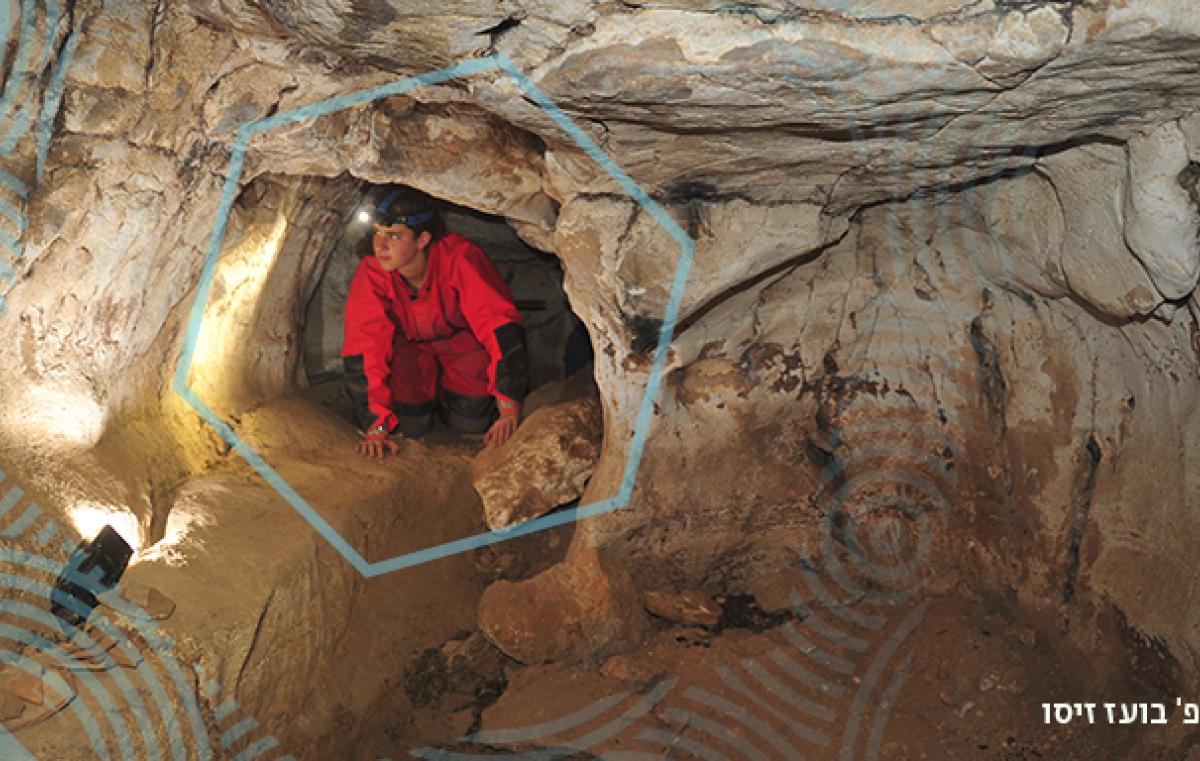Rare Silver Coin Discovered
Coin among first remnants from the Bar Kokhba revolt discovered in the caves of Wadi Chariton

A rare silver coin was recently discovered along with other findings during an archeological survey conducted by a group of researchers from the Institute of Archaeology at Bar-Ilan University and the Institute of Earth Sciences at the Hebrew University, led by Dr. Dvir Raviv, Prof. Amos Frumkin and Prof. Boaz Zissu.
During the survey, a dozen caves located on the eastern bank of the Wadi Chariton Canyon, also known as Nahal Teqoa, were examined. Finds belonging to Jewish rebels who hid in two of these caves – Oil Lamp Cave and Fungus Cave – during the Bar Kokhba revolt (132-136 AD) were discovered. The caves are located about a kilometer north of the famous Chariton Cave -- the longest limestone cave in Israel.
Among the finds is a silver coin in the value of a tetradrachm (also known as sela of the Talmudic sources) that was discovered in the Oil Lamp Cave and is considered particularl rare. Coins of this type have so far been discovered by archaeologists at just three sites (Sela Cave in the upper Naḥal Ḥever, Sabar Cave north of Ein Gedi and the Teʾomim Cave in the western Jerusalem hills), while thousands of Bar-Kokhba's tetradrachms, known in the antiquities market and in private collections, were discovered during illegal excavations.
One side of the silver coin bears a schematic façade of a temple, which likely represents the temple in Jerusalem that was destroyed in 70 AD, above it a star-like image and on both sides the inscription 'Shimon' – Bar Kokhba's first name. The temple facade image includes an enigmatic description of an object or architectural symbol that many scholars have suggested is the showbread table. On the other side of the coin are the four species and around them is the inscription ' For the Freedom of Jerusalem', which is typical of coins minted from the third and fourth years of the revolt (134-136 AD).
The image of the four species that appears on the coin is commonly seen as representing the opinion of Rabbi Akiva (in Mishnah Tractate Sukkah, Chapter 3, Mishnah 4: "Just as one lulav and one etrog, so one myrtle and one willow") mentioned in Talmudic sources as an ardent supporter of Bar Kokhba. The symbols and slogans on the coins of the Bar Kokhba revolt declared the rebels' goals - political freedom and the liberation of Jerusalem from the Roman occupier after the destruction of the city. Traces of the underlying Roman coin can be seen on both sides -- since Bar Kokhba coins are different from the rest of the ancient world coins as they were minted on coins that were already in circulation -- on one side above the temple an eagle's head can be seen and on the other, above the four species are traces of a face, with a hair style resembling that of Emperor Nero. It is interesting to note that many of the tetradrachms in circulation during the Bar Kokhba days were minted during the reign of Emperor Nero (54-68 CE) and are called 'Neron sela'im' in Talmudic sources. The 'sela' from the Oil Lamp Cave shows that this cave was used towards the end of the war, similar to what is implied from the numismatic testimony from other refuge caves in the Land of Judea.
In the absence of a written finding, it's impossible to determine from where the refugees came to the caves of Wadi Chariton and it must be assumed that they fled from Herodium or one of the surrounding villages such as Tel Teqoa and Khirbet en-Natash.

This is the first time that remnants from the Bar Kokhba revolt have been discovered in the caves of Wadi Chariton. Until the current survey, the absence of these finds from the caves was an anomaly, given two important facts: One is the location of Wadi Chariton at the foot of Herodium Fortress, which was a fortified administrative center of Bar Kokhba, and the other is the multitude of natural caves in the river cliffs that may have served refugees and warriors, similar to dozens of caves throughout Judea where finds from the revolt were discovered. Thus, the current survey adds information to other systematic surveys conducted in the last decade in the Judean Desert and Samaria that indicate the extensive use of natural caves for refuge and hiding during the Bar Kokhba revolt.
In addition to the Bar Kokhba finds, a variety of finds from the Late Chalcolithic, Intermediate Bronze Age, Iron Age, Hellenistic, and Early Islamic periods were found in the present survey. Prominent among these finds are a copper mace-head from the Chalcolithic period and a dagger head fragment made of copper from the Intermediate Bronze Age. Signs of illegal excavations were also observed in all the caves surveyed. These may teach about additional archaeological finds, which unfortunately were looted by antiquities thieves.
The research was published in the Israel Exploration Journal.